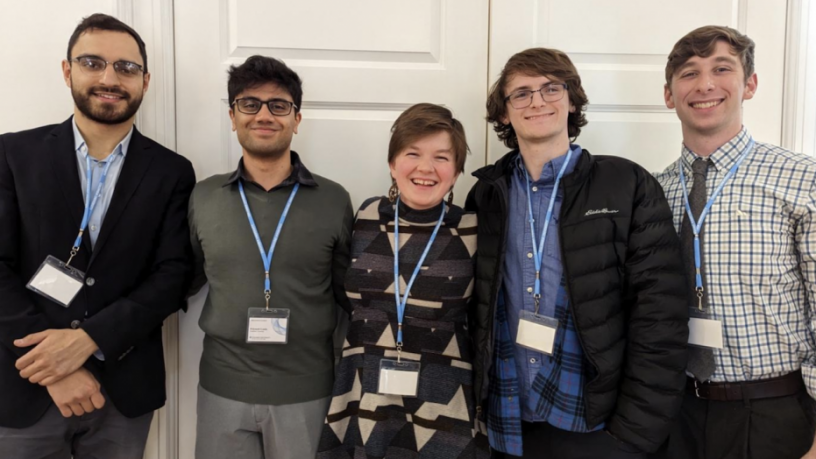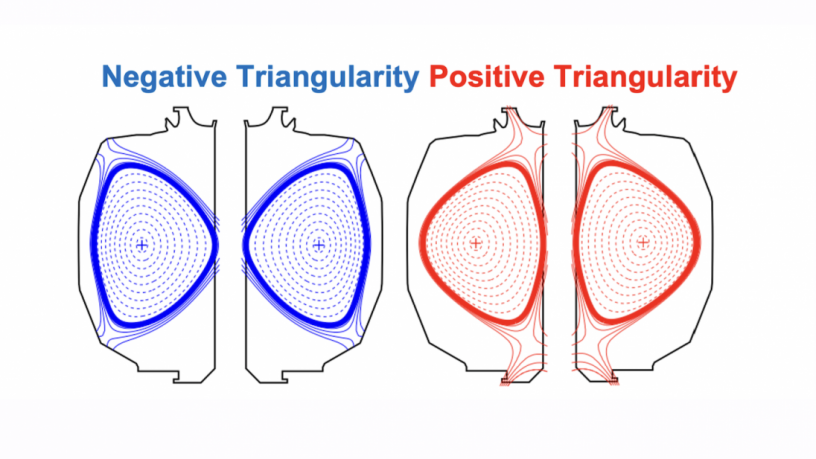Columbia Engineering Students win Fusion-Energy Design Contest
A team of Columbia Engineering PhD students have been awarded $22,000 for winning a design contest that challenged university teams across the country to accelerate the commercialization of fusion energy. The Columbia team was composed of PhD students studying plasma physics in the APAM Department, and their work was supported by Columbia research scientist Dr. Oak Nelson.

Figure 1: The APAM PhD-student team that won the ORFEAS fusion design contest. From left, Hari Choudhury, Priyansh Lunia, Haley Wilson, Matt Pharr, and Matt Tobin.
Fusion energy promises to be a sustainable, safe, and low-carbon method of electricity production that could play a key role in reducing global emissions of greenhouse gases. In the core of a fusion device, at temperatures so high that all gases ionise to form plasmas, light isotopes fuse together to form heavier elements, releasing energy in the process. This energy can then be converted into electricity. There are several different types of fusion devices being actively researched and built worldwide by both public and private organisations, all with the hope of proving commercial-viability of electricity production.
Of all the concepts, the tokamak, a doughnut-shaped machine that confines plasma using magnetic fields, has been proven to have the best fusion performance. The Columbia team studied a variation of the design of the traditional tokamak, known as the negative-triangularity tokamak, over the summer.
In a tokamak, a series of electromagnetic coils produce magnetic fields that spiral around the inside of a doughnut-shaped vacuum vessel, and the plasmas confined typically have a ‘positive-triangularity’ shape, when viewed from a cross-section of the tokamak, see Figure 2, right-side. A different configuration of coils can change this cross-section to form a ‘negative-triangularity’ shape, see Figure 2, left. This new shape holds several advantages for confining the hot plasma compared to the traditional shape, and is the subject of an increasing amount of research and experimentation.

Figure 2: A poloidal cross-section of a tokamak plasma, showing in blue the negative triangularity shape, and in red, the more conventional positive triangularity shape.
Over the summer, after completing a literature review of the topic, the student team modelled the confinement properties of this promising type of tokamak using a suite of software tools. In the process, the students laid the groundwork for a Fall semester class, APPH 9143, which took place in collaboration with MIT, that looks to design a commercially-viable negative-triangularity tokamak. The research conducted in the summer, alongside the work done in the Fall class by Columbia and MIT students, will help understand the feasibility of this mode of tokamak operation and whether it can accelerate the achievement of commercial fusion energy.
The summer research culminated in submitting a report on the potential of this type of tokamak design to ORFEAS, a philanthropic organisation that created the design contest with the hope of accelerating progress in fusion energy. At the end of the summer, the team found out they had won the contest, along with a handful of other teams. All of the winning teams were invited out to the Massachusetts Institute of Technology for a weekend in October to meet each other, share their designs, and learn more about fusion energy.
The team have decided to use the prize money to expand Columbia’s outreach efforts relating to fusion, hoping to take advantage of the university’s unique location in the heart of New York City, with so many schools and students within a commuting distance. Ideas include building new demonstration equipment so high-school students can see examples of plasmas in the class room. The team hope to spread awareness about fusion energy, and, in particular, its far-reaching potential to provide clean, safe, carbon-free electricity.
Team members: Advised by Andrew Oak Nelson (Research Scientist) – aon2113
Hari Paul Choudhury - hpc2111
Matthew Tobin - mtt2136
Haley Sunshine Wilson - hsw2119
Priyansh Lunia - pl2522
Matthew Pharr - mcp2198
Links:
ORFEAS website - https://www.orfeasfusion.com/
Contact:
Hari Paul Choudhury - [email protected]
